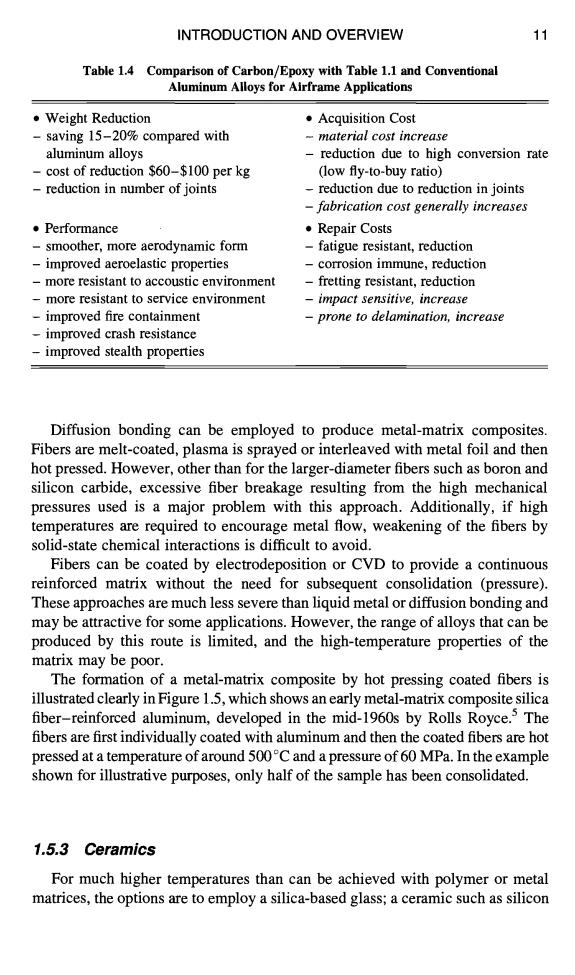正在加载图片...

INTRODUCTION AND OVERVIEW Table 1.4 Comparison of Carbon/Epoxy with Table 1.1 and Conventional Aluminum Alloys for Airframe Applications ·Weight Reduction ·Acquisition Cost saving 15-20%compared with -material cost increase aluminum alloys reduction due to high conversion rate cost of reduction $60-$100 per kg (low fly-to-buy ratio) reduction in number of joints reduction due to reduction in joints -fabrication cost generally increases ◆Performance ·Repair Costs smoother,more aerodynamic form -fatigue resistant,reduction -improved aeroelastic properties corrosion immune,reduction -more resistant to accoustic environment -fretting resistant,reduction -more resistant to service environment -impact sensitive,increase -improved fire containment -prone to delamination,increase improved crash resistance improved stealth properties Diffusion bonding can be employed to produce metal-matrix composites. Fibers are melt-coated,plasma is sprayed or interleaved with metal foil and then hot pressed.However,other than for the larger-diameter fibers such as boron and silicon carbide,excessive fiber breakage resulting from the high mechanical pressures used is a major problem with this approach.Additionally,if high temperatures are required to encourage metal flow,weakening of the fibers by solid-state chemical interactions is difficult to avoid. Fibers can be coated by electrodeposition or CVD to provide a continuous reinforced matrix without the need for subsequent consolidation (pressure). These approaches are much less severe than liquid metal or diffusion bonding and may be attractive for some applications.However,the range of alloys that can be produced by this route is limited,and the high-temperature properties of the matrix may be poor. The formation of a metal-matrix composite by hot pressing coated fibers is illustrated clearly in Figure 1.5,which shows an early metal-matrix composite silica fiber-reinforced aluminum,developed in the mid-1960s by Rolls Royce.The fibers are first individually coated with aluminum and then the coated fibers are hot pressed at a temperature of around 500C and a pressure of 60 MPa.In the example shown for illustrative purposes,only half of the sample has been consolidated. 1.5.3 Ceramics For much higher temperatures than can be achieved with polymer or metal matrices,the options are to employ a silica-based glass;a ceramic such as siliconTable 1.4 INTRODUCTION AND OVERVIEW Comparison of Carbon/Epoxy with Table 1.1 and Conventional Aluminum Alloys for Airframe Applications 11 • Weight Reduction - saving 15-20% compared with aluminum alloys - cost of reduction $60-$100 per kg - reduction in number of joints • Performance - smoother, more aerodynamic form - improved aeroelastic properties - more resistant to accoustic environment - more resistant to service environment - improved fire containment - improved crash resistance - improved stealth properties • Acquisition Cost - material cost increase - reduction due to high conversion rate (low fly-to-buy ratio) - reduction due to reduction in joints - fabrication cost generally increases • Repair Costs - fatigue resistant, reduction - corrosion immune, reduction - fretting resistant, reduction - impact sensitive, increase - prone to delamination, increase Diffusion bonding can be employed to produce metal-matrix composites. Fibers are melt-coated, plasma is sprayed or interleaved with metal foil and then hot pressed. However, other than for the larger-diameter fibers such as boron and silicon carbide, excessive fiber breakage resulting from the high mechanical pressures used is a major problem with this approach. Additionally, if high temperatures are required to encourage metal flow, weakening of the fibers by solid-state chemical interactions is difficult to avoid. Fibers can be coated by electrodeposition or CVD to provide a continuous reinforced matrix without the need for subsequent consolidation (pressure). These approaches are much less severe than liquid metal or diffusion bonding and may be attractive for some applications. However, the range of alloys that can be produced by this route is limited, and the high-temperature properties of the matrix may be poor. The formation of a metal-matrix composite by hot pressing coated fibers is illustrated clearly in Figure 1.5, which shows an early metal-matrix composite silica fiber-reinforced aluminum, developed in the mid-1960s by Rolls Royce. 5 The fibers are first individually coated with aluminum and then the coated fibers are hot pressed at a temperature of around 500 °C and a pressure of 60 MPa. In the example shown for illustrative purposes, only half of the sample has been consolidated. 1.5.3 Ceramics For much higher temperatures than can be achieved with polymer or metal matrices, the options are to employ a silica-based glass; a ceramic such as silicon